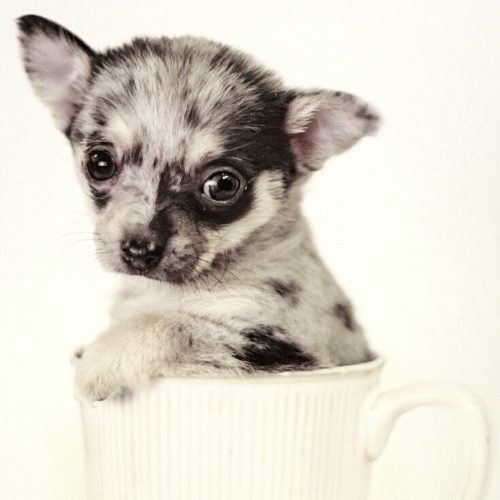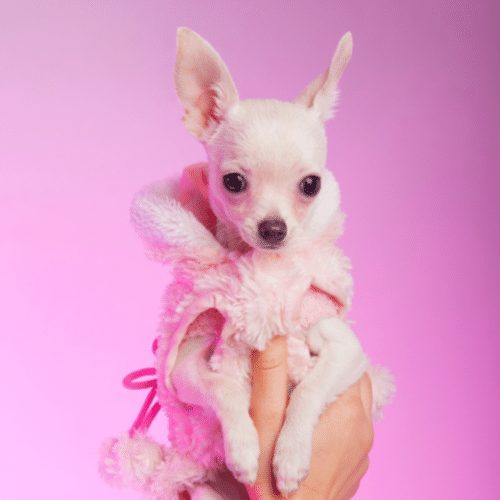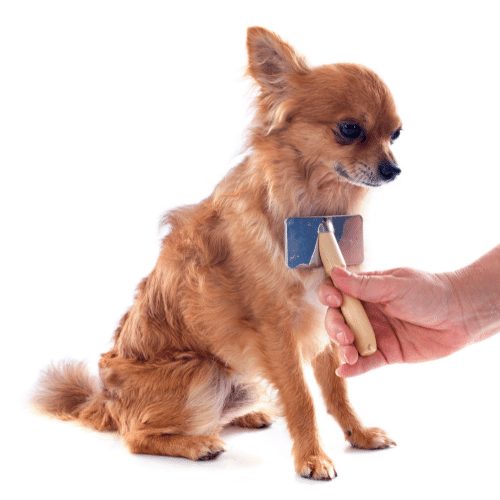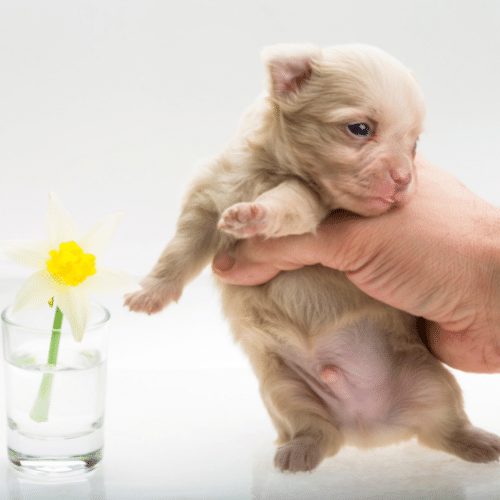Teacup Chihuahuas
May 27, 2021 2021-12-28 18:27Teacup Chihuahuas are pure-bred Chihuahuas that are smaller than average. They aren’t technically their own breed or anything of that sort. Instead, they are tiny Chihuahuas that are marketed as “teacup” or “micro.”
Usually, these dogs are only about 6″ tall when full grown and weigh around 3 pounds. Because they are not a completely separate breed, there is no agreed-upon maximum for this breed. Often, these dogs may not be much smaller than your average Chihuahua, or they could be much smaller. It simply varies. It is also challenging to determine how big a puppy will grow to be, which may mean that some “teacup” Chihuahuas aren’t smaller than regular Chihuahuas.
While these dogs are extra-cute due to their small size, their small stature also provides a few unique challenges. In this article, we’ll take a look at everything you need to know about these tiny dogs.
Table of Contents


Appearance
There is no set standard for the Teacup Chihuahua. Different breeders may consider different dogs to fall into the teacup category, leading to some argument regarding what dogs exactly fall into what category.
Chihuahuas are the smallest dogs in the world. They typically stand anywhere from 6″ to 10″ when full-grown. Most weigh between 4 and 6 pounds. Teacup Chihuahuas are typically anything smaller than this. For this reason, most define them as weighing under 4 pounds and standing at less than 6″.
Again, though, it mostly depends on who you ask. Some may consider tiny Chihuahuas to still count as “teacup,” even though they technically fall into the range of an average Chihuahua.
There are two different kinds of Chihuahuas: smooth-haired and long-haired. This still holds for teacup Chihuahuas as well. Some kennel clubs consider these two variants different breeds, but others group them as the same breed.
In most cases, teacup Chihuahuas cannot enter conformation shows because they do not fall within the range of the breed standard. However, in some areas, smaller dogs are accepted and even preferred. Chihuahuas do not mature based on the size they are as puppies and don’t necessarily match the size of their parents. This makes it difficult to determine how large a dog will be when it becomes older, which may complicate what counts as a “teacup.” Two teacup parents may not produce and teacup puppies, for instance.
Chihuahuas can come in basically any color combination. Nearly any color or pattern is accepted, and one is not necessarily considered more highly than others. The merle pattern has become more popular in recent years, and is seen in a growing number of Teacup Chihuahuas.
History
Chihuahuas have an ancient and varied history. Because of their age, we don’t know exactly how they developed. There are several theories. We know that Chihuahuas were around before the late 1800s, as this is the first time we have particular records. However, they were likely around far before that – just without any proper records.
Some debate that the Chihuahua is descended from the Techichi dog that was domesticated by several Mesoamerican civilizations. These dogs probably weighed about 10 to 20 pounds, which would make them larger than the Chihuahua today. They do share many physical characteristics, though. There is lots of evidence of the Techichi dog existing in ancient civilizations, including paints, statues, and even remains.
These dogs were an essential part of this ancient culture. They were used for religious purposes, as well as for food. However, they didn’t fare well when their owners were invaded by the Spanish conquistadors and nearly went extinct.

There is lots of debate regarding how these dogs got so small – if they are the source of the modern Chihuahua. The dog could have been bred smaller over time through selective breeding, or it could have been crossed with a smaller dog that was brought over with the Europeans. We don’t have the connection between the Chihuahua and the Techichi, but it is possible that the later dog was developed into the dog we know today.
Another theory suggests that the Chihuahua is descended from European dogs that were brought over with colonizers. There is a dog from Malta that shares unique physical characteristics with the Chihuahua. For instance, these ancient dogs have a soft spot on their heads, which many Chihuahuas have today. There is also other evidence of a Chihuahua-like dog existing in Europe before the time of colonization, such as paintings in the Sistine Chapel.
Science has backed up the Techichi origin story. One study found that there was no DNA connection between Chihuahuas and European dogs. However, they did discover similar DNA in other pre-Columbian dogs. This suggests that the Chihuahua at least shares ancestry with the Techichi.

Personality and Temperament
The teacup Chihuahua is known for having a confident and terrier-like temperament. They are known for being similar to other small dogs in terms of their behavior and temperament. They tend to be very loud and bark at just about everything. We don’t recommend them if you want a quieter dog. It is often challenging to train their bark out of them. It is simply how they act!
They tend to be single-person dogs. They will bond closely with one person and ignore everyone else. They tend to be suspicious of strangers, but sometimes their need for affection overcomes this. They will make friends with others if adequately introduced and given plenty of time to warm up.
These dogs can be timid if not socialized properly as a puppy. They need to be introduced to lots of people and other animals when they are young. Otherwise, they can be a bit overwhelmed when meeting new people and become fearful. As smaller dogs, it doesn’t take much for something to scare them, leading to aggression.
Training and Exercise Need of a Teacup Chihuahua
Teacup Chihuahuas aren’t the most intelligent dogs out there, but they can learn quite a few things. Due to their small size, potty training can be difficult. This isn’t so much because they won’t go outside. Their bladders are just so tiny that they need to use the bathroom often. This sometimes means that you’ll need to take them outside every 30 minutes or so, even when they reach adulthood.
Most people invest in an indoor place where their dogs can use the bathroom for this reason. Doggie doors are beneficial if you’re in a situation to install one. They allow the dog to go outside independently so that you don’t have to take them outside quite as much. Just remember that these dogs are tiny, so the doggy door must be appropriately sized for them. Many are much too heavy or sit up too high for these dogs to access.
Socialization is crucial. These dogs tend to be a little impatient with children and other dogs. They aren’t the friendliest canines out there and can be a bit aloof. Protective aggression is standard if they feel like their owner is in trouble, though many dogs mistook visitors as “trouble.” This is why it is essential to have visitors over regularly when the dog is a puppy. They must be used to other people in their homes or spell disaster when they are older.
These dogs typically don’t get along well with other canines. Fear is often a significant driving force in this regard. Many are terrified of being stepped on or bit by a larger dog. To prevent this, they may decide that acting big and bad is their best option. This can lead to a lot of antisocial behavior, such as snapping, barking, and generally not getting along with others. Socialization can prevent this somewhat, primarily if it provides a chance for the dog to gain confidence when interacting with others.
Confident dogs typically aren’t scared.
Health and Care
These puppies can be prone to a few different health conditions, most of which are caused by their much smaller size. It isn’t uncommon for these dogs to get injured, for instance, as they are simply more delicate than other dogs. Many of these diseases can’t be prevented through good breeding, as the dog’s small size causes it. If a breeder was going to prevent many of these diseases, they would have to make the dog larger.
It is essential only to purchase your puppy from a reputable breeder. Otherwise, you may end up adopting a puppy with lots of health problems. Be sure to ask for health testing that either of the parents has undertaken and the puppy’s health records. There are some genetic conditions that all Chihuahuas should be tested for before they are bred. If the breeder did not do this testing, they don’t have the puppies’ health in mind.
Common Health Issues
Patellar Luxation
This is one of the more common genetic diseases the Teacup Chihuahua is prone to. It is common in many smaller dogs and involves the kneecap slipping out of place. Usually, the patellar (kneecap) sits in a groove. Sometimes, it can slip out of place. This can be due to a genetic problem that caused the bones not to line up correctly, though injury can also cause it. Both are decently common causes in these small dogs due to their delicate nature.
Hypoglycemia
Low blood sugar is prevalent in these dogs due to their smaller size. Regular Chihuahuas tend to have hypoglycemia as well, but the teacup variety is even more prone to a fall in blood sugar. This often happens when the dog is not fed often enough. Because they are so small, they need to eat often. For the smallest dog, this often means five to six meals a day. Many owners choose to free-feed for this reason, though the dog’s weight will need to be watched extra-closely in these situations.
This condition can be fatal if the puppy is not treated right away. Often, dogs with this condition will appear tired and listless. Eventually, they will collapse, have convulsions, and then die. This can happen very fast because these dogs are tiny. They cannot hold much food in their stomach at once, so it tends to get digested quickly. After that, they have no way of raising their blood sugar until they eat again.
Excess exercise can also cause this problem, as most teacup Chihuahuas do not have fat reserves to stabilize their blood sugar during times of stress or exercise.
Collapsed Trachea
While this condition is not entirely understood, it can be severe. For one reason or another, a dog’s trachea may collapse, making it difficult for them to breathe. Unless treated, this typically ends in death.
This disease seems to be most common in certain breeds, so it is likely genetic. However, the exact cause and gene that leads to this disease are not known. Chihuahuas are not heavily affected, but they can develop this disease.
Pulmonic Stenosis
This inherited heart condition is characterized by a malformation of the pulmonic valve. Because of this defect, blood cannot flow through the heart correctly. The heart must work harder to push the blood through, eventually leading to it enlarging. After enough time, this will lead to heart failure.
Treatment for this disease varies depending on the stage and severity. It is essential to get it diagnosed early before the heart has had much time to enlarge. In very mild cases, no treatment may be necessary. However, surgery may be needed in other cases.
Neurological Conditions
Teacup Chihuahuas are also prone to a variety of neurological conditions. Often, these diseases involve something not developing correctly in the dog’s skull, which leads to some neurological problems in the dog. Many of these conditions are genetic. The dog doesn’t develop correctly because of a mishap in their genes. However, the exact genetic causes are often unknown, so parents cannot be tested before breeding.
Some dogs may be completely healthy and have puppies with neurological problems.
Grooming
These dogs come in two different varieties, as we discussed early. They can be either short-haired or long-haired. However, this doesn’t affect their grooming needs all that much. The long-haired dogs do not need to be brushed often, and they don’t require trimming either. They are one of the most low-maintenance long-haired breeds around.
A quick brushing session once a week is plenty to keep both varieties clean. The short-haired variety does shed more than the long-haired one, but they still shouldn’t require extensive brushing. A small rubber grooming mitt is often plenty for this purpose, and most dogs prefer these grooming tools over traditional brushes. Long-haired dogs may need a pin brush to get deeper into their coat, but this is often unnecessary. It mostly depends on how dirty your dog gets, as the pin brush helps remove debris lodged in the dog’s coat.
Teacup Chihuahuas shed small amounts throughout the whole year. Some of them may shed particularly severely in the spring and fall, depending on your local climate. In this case, you may need to increase your brushing every day for a short time to remove the excessive amounts of hair they may shed.


They don’t typically need a bath very often. It is recommended to avoid bathing them, as they can chill quickly due to their petite size. Regular brushing is often plenty to keep them clean. If you do need to bathe your dog, be sure to do it in a warm room and dry them thoroughly when you are done. A tiny, wet dog can quickly become too cold.
Their ears may need to be occasionally cleaned, though they are not prone to ear infections. Check them for a build-up of debris whenever you brush your dog and clean them with a cotton ball if necessary. You will also need to trim their nails regularly. Be very careful, as their nails are tiny, and it is easy to cut them too close. You can visit a groomer to do this task for you if you are not confident in your ability.
These dogs are prone to some dental problems, though not as much as other small breeds. For this reason, you must brush their teeth regularly. Otherwise, they can quickly develop expensive dental problems.
Adopting a Teacup Chihuahua
While these dogs aren’t as popular as full-sized Chihuahuas, they are popular enough to draw the attention of many specialized breeders. Many Chihuahua breeders now offer teacup varieties as well. They often do this by simply breeding more miniature Chihuahuas, marketing the smaller puppies in their litters as “teacup.”
It is important to remember that Chihuahuas notoriously do not grow as you’d expect. For this reason, the most miniature puppy may end up being quite large by adulthood. There is no way to tell how large a puppy might grow. Therefore, a “teacup” puppy may not end up being “teacup” sized as an adult. The only way to ensure that you’re getting a smaller-than-average teacup Chihuahua is to adopt an adult.
Many breeders are reluctant to breed Chihuahuas that are under 3 or 4 pounds, as this can negatively affect the dog’s health. Many health conditions can become worse as the dog gets smaller. Plus, the dog may get injured easier if it is far smaller than average.

You can expect to pay anywhere from $1,500 to $3,000 for a Teacup Chihuahua. The price often varies based on gender and color. Some coat colors are sought after for pet dogs, which can make these puppies somewhat expensive. If you’re willing to get a Chihuahua with “average” coloring, then you’ll likely have to spend less.
To get a Chihuahua under 4 pounds, you don’t necessarily have to shop for Teacup varieties. Many breeders of regular Chihuahuas will have smaller-than-average puppies as well.

Experience Level for Owning a Teacup Chihuahua
We only recommend these dogs for advanced dog owners. This is due to their unique care needs, such as frequent meals and their high socialization needs. These dogs require a lot of particular care, and experienced owners can provide this care the easiest. These dogs have a steep learning curve, but they are not sturdy enough to put up with mistakes. Not feeding a puppy enough can quickly lead to its death in less than 24-hours, for example. Dropping a puppy can cause severe and life-threatening injuries.
For a new owner, all of these needs can quickly become stressful, especially when small mistakes can lead to severe injuries.
The Bottom Line
Teacup Chihuahuas are tiny, which also makes them quite cute. However, they are also very delicate dogs due to their smaller size. They are more prone to certain health conditions, most of which are caused by their small size or are genetic.
Their socialization and training needs are pretty high. It is challenging to potty-train them as their bladders are pretty small. Many people opt out of potty training and use some other method instead, like an indoor “grass” patch. They are often fearful and aloof when it comes to strangers and other dogs. Protective aggression and separation anxiety is not uncommon.
These dogs need specialized care to thrive. Otherwise, they can develop health conditions and become aggressive. When taken care of, though, they can be great companions that can fit in your pocket. We recommend these dogs for those that spend a lot of time at home and want a dog that will be truly devoted to them – even if it means dedicating a bit extra time and work to their puppy.

